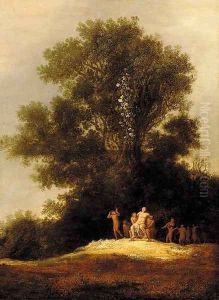Dirk The Elder Dalens Paintings
Dirk Dalens, or Dirck Dalens the Elder, was a Dutch landscape painter born in 1600 in the city of Antwerp, which at the time was part of the Spanish Netherlands (present-day Belgium). His work primarily reflects the Dutch Golden Age of painting, a period when Dutch art was highly regarded and characterized by great wealth and cultural achievement within the Netherlands.
Dalens moved to Amsterdam in the Dutch Republic where he became a pupil of Claes Cornelisz. Moeyaert, a Dutch Golden Age painter known for his landscapes and mythological scenes. Dalens' own style was heavily influenced by his mentor, but he also developed his own distinct approach to landscape painting. His works often depicted woodland scenes, river valleys, and pastoral landscapes with figures and animals that exhibit a serene and harmonious quality. These paintings reflect the Dutch appreciation of nature and the countryside, as well as the influence of Flemish landscape traditions.
Dalens married and had a son, Dirk Dalens the Younger, who followed in his father's footsteps to become a painter, suggesting that there was an artistic environment in their household. Throughout his career, Dalens the Elder was an active member of the Amsterdam Guild of St. Luke, which was the city's painters' guild. This suggests that he was a respected member of the artistic community in Amsterdam.
Dalens' works were collected by art patrons of his time, contributing to his reputation as a skilled landscape artist. His paintings can be categorized by their detailed representation of natural elements, their use of light, and the subtle interplay of colors. Dalens' landscapes are typically idyllic and peaceful, reflecting the idealized view of nature that was popular during the Dutch Golden Age.
Dalens died in 1676 in Amsterdam. Although he is not as well-known today as some of his contemporaries, his work remains an important part of the Dutch landscape tradition. His paintings continue to be valued for their historical significance and artistic merit, and can be found in various art museums and private collections around the world.
